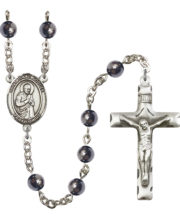Saints
St. Isaac Jogues and the Eight North America Martyrs
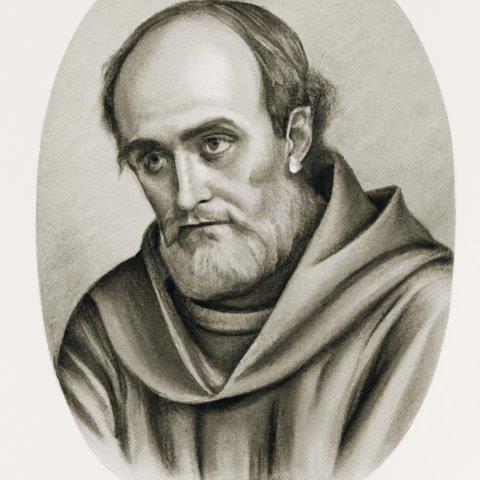 A fleet that sailed from France in the year 1636 carried a small band of newly ordained Jesuits who had volunteered to work in the wilderness of North America. These well-educated, cultured Frenchmen were leaving home, family, safety, and comfort to work among the savages of New France. They knew they faced greater hardships and possible martyrdom. Father Isaac Jogues and Father Charles Garnier were two members of this band.
A fleet that sailed from France in the year 1636 carried a small band of newly ordained Jesuits who had volunteered to work in the wilderness of North America. These well-educated, cultured Frenchmen were leaving home, family, safety, and comfort to work among the savages of New France. They knew they faced greater hardships and possible martyrdom. Father Isaac Jogues and Father Charles Garnier were two members of this band.
St. Isaac Jogues was a French Jesuit missionary, martyr and saint. He was one of the first European explorers to navigate the Mohawk River in the Mohawk Valley of what is now upstate New York, and was known for his efforts to convert the Native American people to Christianity.
Isaac Jogues was born in 1607 in Orléans, France, and entered the Society of Jesus (Jesuits) in 1624. In 1636, he was sent to the New World as a missionary, and landed in Quebec, Canada. He was then sent to the Huron-Wendat mission, where he worked with the Huron people for four years, learning their language and customs.
In 1642, Jogues and his companions were captured by the Mohawk people, who were traditional enemies of the Hurons. Jogues and his companions were treated brutally and tortured, but Jogues was able to maintain his faith and continue to minister to the Mohawks, even though he was held in captivity for 13 months.
In 1643, Jogues and his companions were able to escape and returned to France, where he was greeted as a hero and spent time recuperating from his injuries. However, he wanted to return to the New World and continue his mission among the Native Americans. He returned to North America in 1646 with a new group of Jesuits.
Jogues and his companions were able to establish a new mission among the Mohawks, but they met with intense resistance from the Mohawk people and other tribes. In 1646, Jogues and his companion were killed by their captors. He was canonized by Pope Pius XI in 1930, and is considered a martyr for his efforts to spread Christianity among the Native American peoples.
Jogues’ devotion to the native people of America and his will to continue his mission despite facing immense danger and suffering, even unto death, has made him a symbol of selflessness, courage and faith.
St. Isaac Jogues is the patron saint of North America and is also considered the patron saint of ecologists, geologists, and of the Mohawk nation. His feast day is celebrated on October 19th, by the Catholic Church. His legacy lives on through the many schools and parishes named after him, as well as the annual pilgrimage to the site of his martyrdom in Auriesville, New York.
Biography of St. Charles Garnier and St. Isaac Jogues
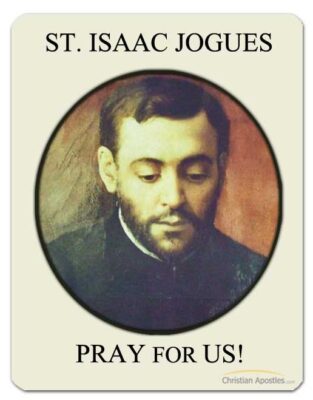 Isaac Jogues was born at Orleans in 1607, of a solid middle class family. Charles Garnier was born in Paris in 1605. Both young men had to overcome strong parental opposition before they could enter the Society of Jesus. Both men had great devotion to the Blessed Mother, and Garnier had made a vow to uphold her Immaculate Conception until death.
Isaac Jogues was born at Orleans in 1607, of a solid middle class family. Charles Garnier was born in Paris in 1605. Both young men had to overcome strong parental opposition before they could enter the Society of Jesus. Both men had great devotion to the Blessed Mother, and Garnier had made a vow to uphold her Immaculate Conception until death.
This was more than 200 years before the doctrine of the Immaculate Conception was defined. When the fleet docked at Quebec, capital of New France, Garnier and others were sent at once to the mission which the Jesuits had established among the Hurons, at the end of Georgian Bay. They joined Father John Brebeuf, S.J.., who for a time had been the only missionary at this outpost. A few months later, Father Jogues also came to the Huron mission. One of the first tasks of these missionaries was to learn the very difficult Huron language. Father Garnier amazed even the Indians themselves by learning the language within six months.
Although the Hurons were enemies of the Iroquois and allies of the French, this fact did not guarantee the French missionaries a warm welcome. The Hurons were savages, steeped in superstition. Moreover, the medicine men did not wish to give up their hold on the people, and so they used every opportunity to discredit the priests. The Hurons lived in great filth, and this filth brought about frequent epidemics, for which the priests were blamed. Adult con versions were rare at first; the missionaries baptized mostly dying people, especially dying children. This made the Hurons even more suspicious. “Every time they pour water on a person, that person dies,” they said.
Ministry to the Native Tribes of North America
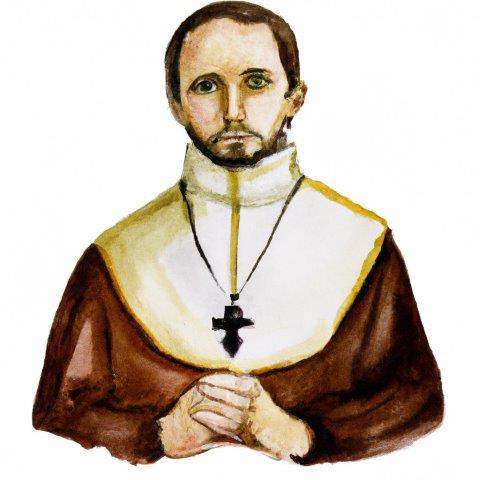 A council of twenty-eight Huron villages was called, and it was decided that the missionaries must die. Father Brebeuf invited the Indians to a farewell feast. Then he spoke to them eloquently of life and death. The Indians were so impressed that they decided to spare the Father and his companions.
A council of twenty-eight Huron villages was called, and it was decided that the missionaries must die. Father Brebeuf invited the Indians to a farewell feast. Then he spoke to them eloquently of life and death. The Indians were so impressed that they decided to spare the Father and his companions.
They were safe for the time being, but the threat of death hung over them constantly. Using the Georgian Bay missions as a base, the Jesuits ranged far afield, among many tribes besides the Hurons. Father Jogues and Father Garnier traveled together among the Petans. Father Jogues and another companion went as far as Sault St. Marie and were the first white men to reach this point, a thousand miles from the Atlantic coast.
Father Garnier paid several visits to the Tobacco nation. He was turned away at first, but his persistence paid off. In time, he would be invited to make his home among the Tobacco Indians. The first adult was baptized in 1637. More than eighty were baptized in 1639, and another sixty in 1641.
St. Charles Garnier is Martyred for his Ministry
This was not spectacular progress, but it was encouraging. Father Jogues volunteered to go to Quebec on an important errand in the summer of 1642. He took along a party of forty, including several lay helpers and a number of Indians, both Christian and non-Christian. When the party was near Three Rivers, on the return trip, it was attacked by a band of Mohawks, fiercest of the Five Nations that comprised the Iroquois confederation. Captors and prisoners reached the Mohawk village of Ossernon (now Auriesville, N. Y.) on the eve of the Feast of the Assumption 1642.
Days and weeks of torture followed. The prisoners were beaten until they fell to the ground, then they were propped up and beaten again. Indian women chewed away parts of their fingers. One Indian woman sawed off Father Jogues thumb with a clam shell.
They were staked to the ground, and Indian children threw hot coals on their naked flesh. Rene Goupil, a lay assistant to Father Jogues, made the Sign of the Cross on the forehead of a child and for this he was tomahawked on September 29. He was saying the Rosary when he was struck. Father Jogues gave him absolution as he died. The Dutch at Fort Orange (now Albany, N. Y.) had been supplying the Indians with guns and fire water so that they would harass the French, but the plight of Father Jogues aroused their sympathy.
They smuggled him aboard a boat and took him to the safety of New Amsterdam on Manhattan Island. From there he was able to book passage for France on a small ship that barely withstood the winter. On Christmas Day, 1642, Father Jogues reached the Jesuit college at Rennes and told the superior that he had come from New France. “Then perhaps you can tell me something about Father Jogues,” said the superior. “We heard that he had been captured by Indians.
St. Isaac Jogues Continues His Ministry
The visitor held out his mangled hands and said: “I am Jogues.” Father Jogues thought that he would never be able to say Mass again because his hands were so badly mangled. However, Pope Urban VII gave him special permission to do so, saying: “It would be unjust if a martyr of Christ should not drink the blood of Christ.”
Father Jogues could have remained in France, but he was burning with a desire to get back to the Indians. When he arrived in Quebec, Governor Montmagny asked him if he would undertake a peace mission to the Iroquois. The Five Nations, armed with guns from the Dutch, had become exceedingly powerful and planned to eliminate the other Indians and the French from the eastern part of North America. No doubt they eventually planned to turn on the English, too, and then the Dutch.
Father Jogues was to try to persuade them to live in peace with their neighbors and avoid useless bloodshed. The priest gladly accepted the mission and was received with honor by the very people who had tortured him the year before. The negotiations went well and Jogues went back to Quebec to report that his mission had been successful. He left behind him in Ossernon a box of religious objects, because he planned to return to the village. The Mohawks had a bad crop, and this was followed by an epidemic. They blamed these things on evil spirits in the box.
Martyrdom of Saint Isaac Jogues
 When Father Jogues returned with a layman, Jean Lalande, the two were taken prisoners. The Mohawks debated as to the course they should follow. Some were for honoring the peace and freeing the prisoners. While the debate went on, a young brave Mohawk took matters into his own hands and tomahawked Father Jogues as he was entering a cabin. He died instantly. His head was cut off and placed on a pole facing the route by which he had come.
When Father Jogues returned with a layman, Jean Lalande, the two were taken prisoners. The Mohawks debated as to the course they should follow. Some were for honoring the peace and freeing the prisoners. While the debate went on, a young brave Mohawk took matters into his own hands and tomahawked Father Jogues as he was entering a cabin. He died instantly. His head was cut off and placed on a pole facing the route by which he had come.
The next day Jean Lalande was also tomahawked and beheaded. This was in late October, 1646. The martyrdom of Father Jogues sealed the fate of the Hurons who now had twenty-four Jesuits working among them and were gradually becoming a Christian nation. The Iroquois wiped out one Huron village after another. Father Antony Daniel, S.J., was killed by Indian arrows on July 4, 1648. Father Brebeuf and his companion, Father Gabriel Lalemant, S.J., were captured March 16, 1649, and died after undergoing unspeakable tortures.
The Holy Example of St. Isaac Jogues and St. Charles Garnier
Father Jogues and Father Garnier had crossed the ocean together in 1636, but their paths had been different. Father Jogues journeys had carried him thousands of miles, even back to France for a short time. Father Garnier had never left the mission country.
Father Jogues had shown his love of God by bravely enduring terrible tortures, Father Garnier showed his by his zeal, his patience, and his mortifications. Merely living in the wilderness and cating the scanty fare of the Indians would have been great penance, but he did more. He slept on the bare ground even when a more comfort able bed was available. He wore a girdle with iron points which dug into his skin. He scourged himself with a wire whip on which were sharp points. Because he was of a slight build and seemingly frail, his superior asked him if he wished to give up the life of a missionary.
Three days before his death Father Garnier replied that he would give it up, if necessary, in the spirit of obedience, “but otherwise, I will never come down from the cross on which His goodness has placed me.” Before the end of 1649 the Iroquois penetrated as far as the Tobacco nation and fell on the village where Father Garnier had his mission. The result was a slaughter.
Father Garnier, unmindful of his own fate, hurried about giving absolution to the Christians and baptizing the children. He was shot down by the musket of an Iroquois. He tried to reach a dying man whom he thought he could help, but he did not have strength enough to make it. He was killed by a hatchet blow that penetrated to the brain. This was on the eve of the Feast of the Immaculate Conception.
Father Noel Chabanel, the companion of Father Garnier, was absent from the mission when the massacre took place. When he heard the news he started back. On the way he was killed by a Huron apostate.

The Eight Martyrs Saints of North America
The eight martyrs were canonized in 1930. They are SS. John de Brebeuf, Isaac Jogues, Antony Daniel, Gabriel Lalemant, Charles Garnier, Noel Chabanel, Rene Goupil, and Jean Lalande. They are the first North American saints. A great shrine at Midland, Ontario, honors the five who were martyred in Canada, and another great shrine at Auriesville, New York, honors the three who were martyred there. The saintly Mohawk girl, Veneer able Kateri Tekakwitha, is also honored at Auriesville, because she was born there. This reminds us that the Iroquois later came to include many Catholics, and one of these may someday be declared a saint.
OTHER SAINTS NAMED ISAAC:
- St. Isaac of Constantinople, died 410. Abbot, founder of the Dalmatian monastery in Constantinople. Feast Day: May 30.
- St. Isaac of Spoleto, died 550. Hermit on Monte Luco in Italy. Feast Day: April 11
- St. Isaac of Cordova, died 852. Martyred by Mohammedans in Cordova, Spain. Feast Day: June 3.
OTHER SAINTS NAMED CHARLES:
- St. Charles of Blois, 13201364 Prince and soldier. Feast Day: September 29.
- St. Charles Borromeo, 15381584 Cardinal, Archbishop of Milan, reformer. Feast Day: November 4.
- St. Charles of Sezze, 1613-1670. Franciscan lay brother remarkable for simplicity and charity. Feast Day: January 19.
- St. Charles Lwanga, died 1886. page to a wicked native king, martyred in Uganda, Africa. Feast Day: June 3.
Popular St. Isaac Jogues Medal and St. Isaac Jogues Rosary
Patron Saints - I's
Prayers to St. Isaac Jogues
Prayer to St. Isaac Jogues
Dear St. Isaac Jogues, you were a fearless missionary, driven by your love for God and your desire to spread the Gospel to all people. You endured many trials and tribulations, but never lost your faith or your courage.
I turn to you today, asking for your intercession. Help me to be as steadfast in my faith as you were, and to remain steadfast in the face of adversity. Give me the courage to spread the Good News of Jesus Christ to all those I meet, and to live my life in a manner that brings honor to His name. Amen.
A prayer for the Courage of St. Isaac Jogues
Dear St. Isaac Jogues, I pray for your courage today, that I may be inspired by your bravery and your unwavering faith. Help me to be bold in my witness for Christ, and to never be afraid to speak the truth, even when it is unpopular or unpopular.
Give me the strength to stand up for what is right, even in the face of opposition, and to never compromise my beliefs or my faith. Help me to be a beacon of hope and a source of inspiration to all those I meet, and to live my life in a manner that brings glory to God. Amen.
A prayer for the Intercession of St. Isaac Jogues
Dear St. Isaac Jogues, I turn to you today in need of your intercession. You were a fearless missionary, and I ask that you intercede for me and for all those in need of your help.
Please pray for those who are struggling, that they may find comfort and hope in their trials. Pray for those who are lost, that they may find their way back to the Lord. And pray for all those who are spreading the Good News of Jesus Christ, that they may be blessed with the courage and strength they need to fulfill their mission. Amen.
St. Isaac Jogues: The Patron Saint of North America and Missionaries
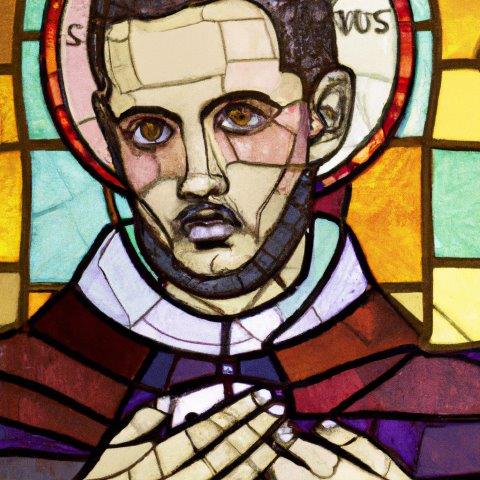 St. Isaac Jogues is the patron saint of North America and missionaries. He lived in the 17th century and was known for his dedicated service to God and his tireless work as a missionary in the Americas.
St. Isaac Jogues is the patron saint of North America and missionaries. He lived in the 17th century and was known for his dedicated service to God and his tireless work as a missionary in the Americas.
St. Isaac Jogues was a French Jesuit priest who travelled to North America to spread the gospel and help establish the Catholic Church in the New World. Despite facing many challenges and hardships, including persecution and enslavement, St. Isaac Jogues never lost his faith or his commitment to God.
His unwavering devotion to God and his tireless work as a missionary have earned St. Isaac Jogues a special place in the hearts of Catholics in North America. He serves as a powerful example of courage and perseverance, and his life reminds us of the importance of spreading the gospel and sharing God’s love with others.
For those who feel called to serve God as missionaries, St. Isaac Jogues offers encouragement and inspiration. He shows us that no matter how difficult our challenges may be, we can stay true to our faith and continue to do good in the world.
” “
Reflection on the feast day of St. Isaac Jogues
The feast day of St. Isaac Jogues is October 19th.
St. Isaac Jogues was a Jesuit missionary and martyr who worked among the Huron and Iroquois peoples in what is now Canada in the 17th century. He is remembered for his tireless efforts to spread the Christian faith, despite facing severe persecution and ultimately giving his life for the cause. He is also remembered for his compassion and his dedication to serving the indigenous people of North America, who were often treated unjustly by the colonizers.
On his feast day, we can reflect on the importance of mission and the sacrifices that are sometimes required in order to spread the faith. St. Isaac Jogues faced many challenges and dangers as a missionary, yet he persisted in his efforts to share the message of Christianity with the Huron and Iroquois peoples. His dedication and willingness to sacrifice for the sake of spreading the faith is an inspiration to all of us to do the same.
At the same time, St. Isaac Jogues can also remind us of the importance of treating indigenous and marginalized people with respect and compassion. He was known for his dedication to the well-being of the people he served, and he worked tirelessly to protect their rights and improve their lives. This is an example that we can all learn from and try to emulate, especially in a world where indigenous and marginalized communities continue to be marginalized and oppressed.
St. Isaac Jogues also reminds us of the importance of perseverance and courage in the face of adversity. He faced many challenges during his mission, including severe persecution, yet he never wavered in his faith and his dedication to spreading the gospel. His unwavering courage and determination is an example for all of us to look up to, especially when we are faced with challenges in our own lives.
In conclusion, the feast day of St. Isaac Jogues is an opportunity for us to reflect on the importance of mission, compassion and respect for marginalized people, perseverance and courage in the face of adversity, and the sacrifices that are sometimes required in order to spread the faith. Let us follow the example of St. Isaac Jogues and strive to make a difference in the lives of others, to protect the rights of marginalized communities, and to remain steadfast in our faith even in the face of adversity.
Discover biographies, prayers, and reflections for more than 400 Catholic Saints
Next up: Biography of St. Isabella of Portugal
Also check out our handmade St. Isaac Jogues Medal and St. Isaac Jogues Rosary and St. Isaac Jogues Rosary Bracelet .

